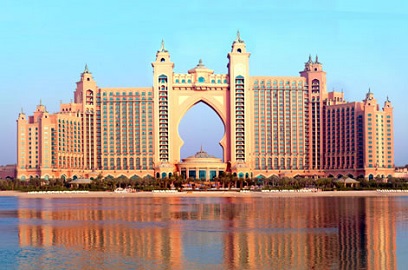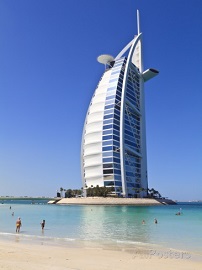Top Architectural Wonders of Dubai
Contents |
[edit] Introduction
Dubai is known for its modern, creative buildings that can be erected quickly and stand out from the crowd in terms of size and design. Some of these architectural wonders have been awarded accolades for their creative design, green credentials and all-round approach.
Below are some of the best.
[edit] Burj Khalifa
The tallest building in the world is over 160 storeys high (829 metres) and is located in Dubai. The Burj Khalifa is a top tourist attraction in the area and the building's architecture has been cleverly assembled, giving its stature. Started in 2004 and completed in 2010, the tip of the spire of the Burj Khalifa can be seen from 95 kilometres away, making it one of the most prominent buildings in the area. You can visit one of the viewing decks and look out on the city skyline – a beautiful sight. This building was built with the need to be recognised internationally, and its amazing architecture now makes it stand proud as one of the most well-known buildings in the world.
[edit] Atlantis, The Palm
Atlantis, The Palm is a beach resort hotel on the man-made Palm Island. The building is based around the myth of Atlantis. Opened by Sol Kerzner in 2008, this building contains 1,539 rooms, 23 restaurants and a nautical-themed water park, amongst other features. There are two towers, referred to as East and West and they are joined together by the Royal Bridge Suite. The architects for this beautiful 23-storey project were from the international firm Wimberly, Tong and Goo.
For more information, see Atlantis, The Palm.
[edit] Cayan Tower
Cayan Tower is also known as the Infinity Tower and is recognised for its interesting twisting shape. It is 306 metres high and was designed by Skidmore, Owings and Merrill (SOM). What makes this building so interesting is the twist itself, which twirls the building around by 90 degrees. Opened in 2013, this fairly new architectural wonder is extremely modern inside and out, filled with Dubai offices and apartments.
[edit] Burj Al Arab
The Burj Al Arab is the third tallest hotel in the world, behind the Rose Rayhaan and the JW Marriott, both also based in Dubai. This establishment rises 280 metres into the sky and stands on its own artificial island, connected to the mainland by a bridge. The architecture of this building is most definitely original, as the idea was for it to look like a relaxed sail of an Arabian ship, called a “dhow”. Led by famous architect Tom Wright, this building was created by 2,000 construction workers and brought to life by over 60 managers and designers – a true architectural feat.
For more information, see Burj al Arab, Dubai.
[edit] Related articles on Designing Buildings Wiki
- 7 Engineering Wonders of the world.
- 9 of the world’s most impressive structures.
- Atlantis, The Palm.
- Bridges of the world.
- Building of the week series.
- Burj al Arab, Dubai.
- Hyperloop in Dubai.
- India needs to build more infrastructure fast. Here’s how.
- Shanghai Tower.
- Tallest buildings in the world.
- The Gherkin.
- Top 10 most expensive construction projects in the world.
- Top 10 skyscrapers located in the UAE.
- Skyscraper.
- Wasl Tower.
Featured articles and news
Latest Build UK Building Safety Regime explainer published
Key elements in one short, now updated document.
UKGBC launch the UK Climate Resilience Roadmap
First guidance of its kind on direct climate impacts for the built environment and how it can adapt.
CLC Health, Safety and Wellbeing Strategy 2025
Launched by the Minister for Industry to look at fatalities on site, improving mental health and other issues.
One of the most impressive Victorian architects. Book review.
Common Assessment Standard now with building safety
New CAS update now includes mandatory building safety questions.
RTPI leader to become new CIOB Chief Executive Officer
Dr Victoria Hills MRTPI, FICE to take over after Caroline Gumble’s departure.
Social and affordable housing, a long term plan for delivery
The “Delivering a Decade of Renewal for Social and Affordable Housing” strategy sets out future path.
A change to adoptive architecture
Effects of global weather warming on architectural detailing, material choice and human interaction.
The proposed publicly owned and backed subsidiary of Homes England, to facilitate new homes.
How big is the problem and what can we do to mitigate the effects?
Overheating guidance and tools for building designers
A number of cool guides to help with the heat.
The UK's Modern Industrial Strategy: A 10 year plan
Previous consultation criticism, current key elements and general support with some persisting reservations.
Building Safety Regulator reforms
New roles, new staff and a new fast track service pave the way for a single construction regulator.
Architectural Technologist CPDs and Communications
CIAT CPD… and how you can do it!
Cooling centres and cool spaces
Managing extreme heat in cities by directing the public to places for heat stress relief and water sources.
Winter gardens: A brief history and warm variations
Extending the season with glass in different forms and terms.
Restoring Great Yarmouth's Winter Gardens
Transforming one of the least sustainable constructions imaginable.


























